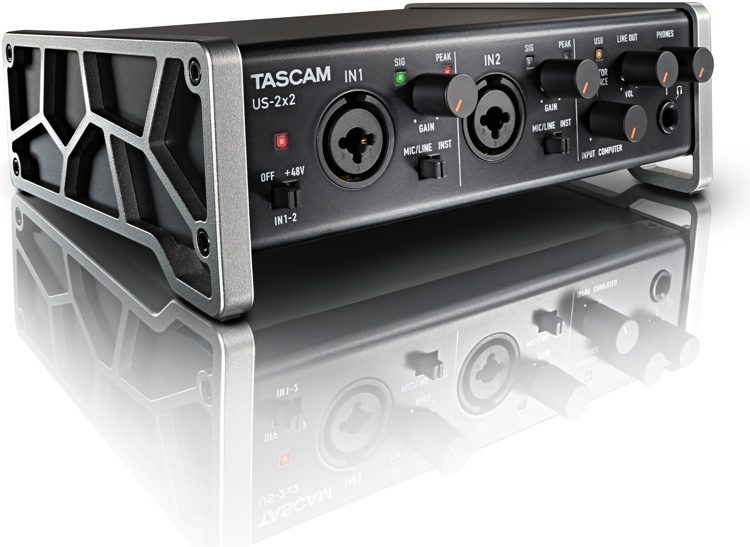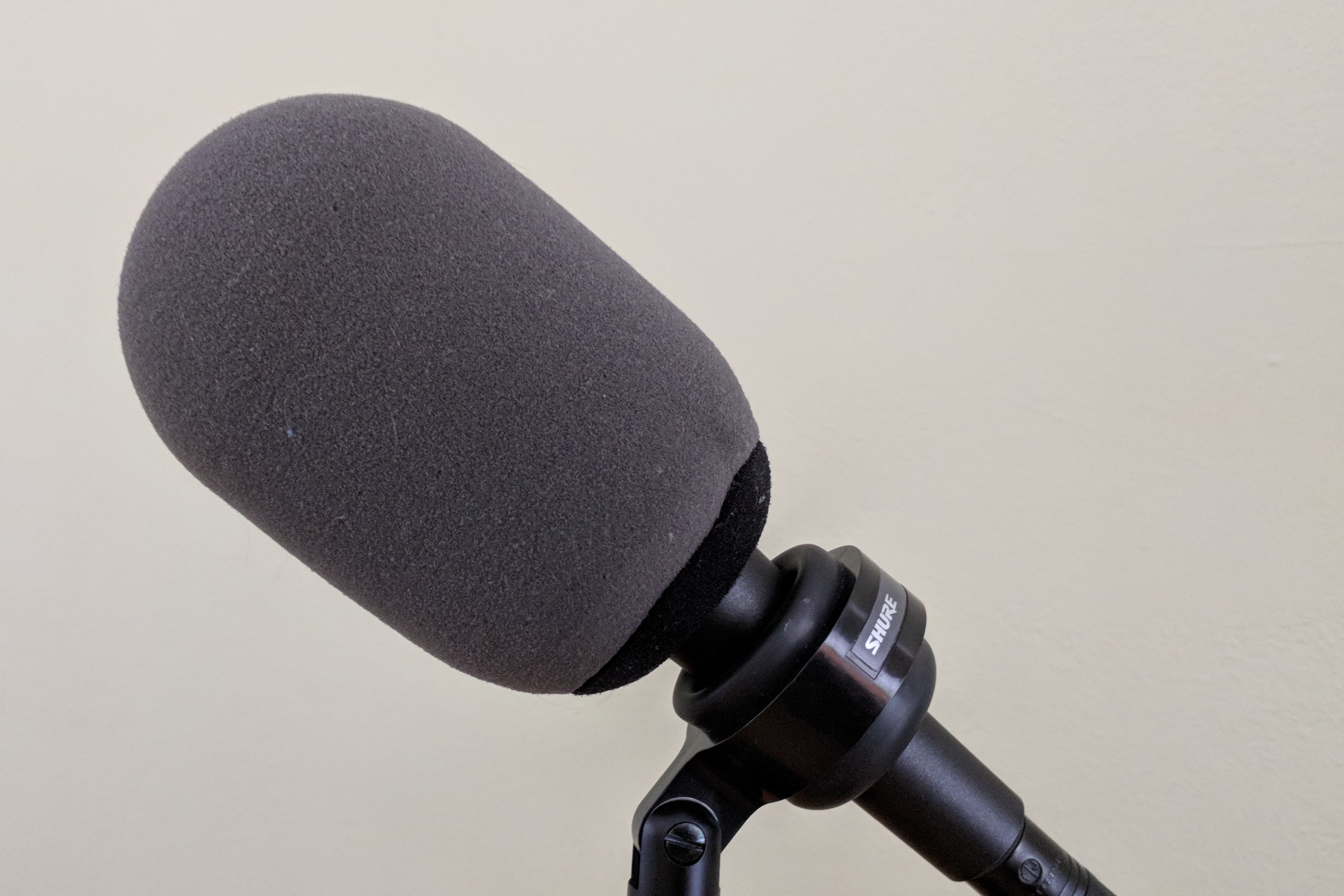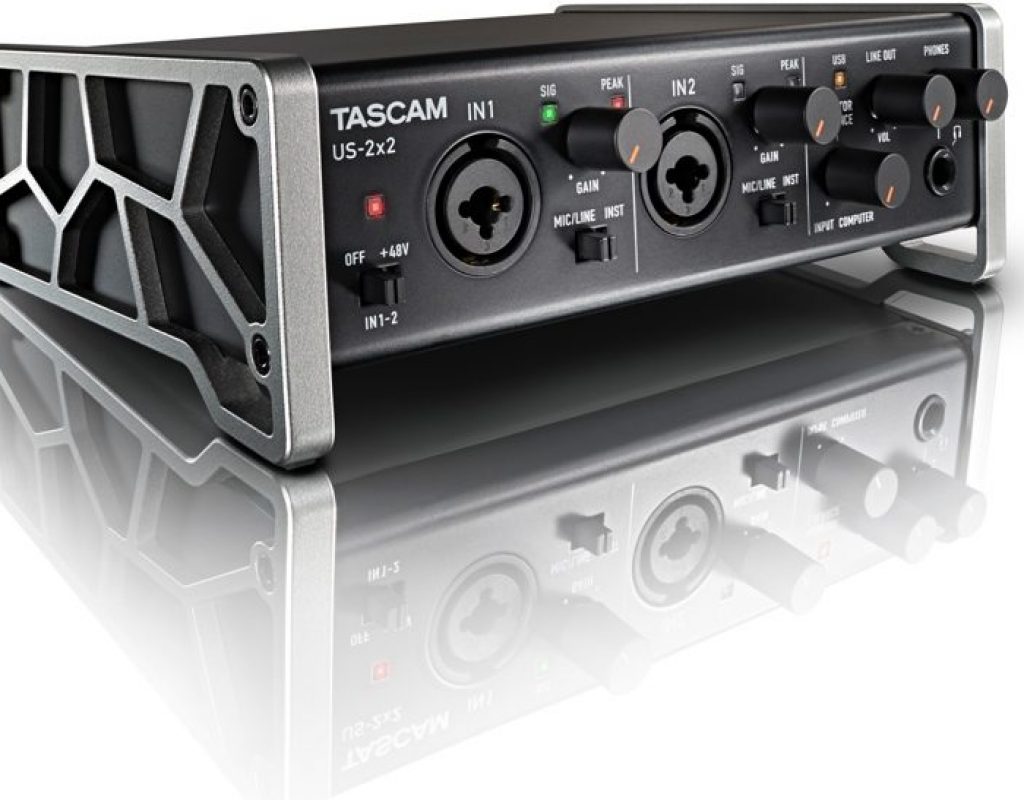
The Tascam US-2×2 is an audio interface which offers two mic preamps/A-D & D-A converters. Those two mic preamps offer up to 57 dB of gain each, with nearly inaudible noise and distortion. I applaud Tascam for publishing this gain spec, since very few interface manufacturers bother to do so in this relatively low price range. That available 57 dB gain is sufficient for all but the most gain-hungry dynamic microphones, especially given details I’ll explain ahead. The US-2×2 is also bus-powered when used with a Chromebook, Mac or Windows computer! (You’ll often need external power to use it with a smartphone or a tablet.) Ahead you’ll learn how to make the US-2×2 work optimally on Mac —without even installing the extremely outdated macOS Tascam software— and hear test recordings I made with both dynamic and condenser microphones.
How I made the main test recording
Whenever I test a preamp, I prefer to do so mainly using a dynamic microphone (not an electret condenser microphone), to be sure that the preamp is working the hardest.

That’s why I made the main recording test for this review using the Pyle PDMIC78 (illustrated above, reviewed here, Amazon — B&H) dynamic microphone using the two Shure accessories which fit it perfectly: the A55M shockmount (Amazon — B&H) and the enormous presidential Shure A81WS windscreen (Amazon • B&H). As nearly always, I made the raw mono WAV recording at 48 kHz/24 bit to Hindenburg Journalist Pro, my favorite multitrack software for Mac for audio storytellers (also available for Windows). See my related Hindenburg Journalist Pro articles… All audio production & distribution should go 48 kHz and also Understanding 24-bit vs 16-bit audio production & distribution.
Main test made with the PDMIC78 dynamic microphone
The above is a a trimmed, normalized, non-compressed mono 48 kHz/16-bit WAV file. Use WiFI unless you have unmetered mobile data.
Auxiliary test made with the RØDE M5 electret condenser microphone
The above is a compressed 48 kHz MP3 file, edited into BeyondPodcasting palindromic episode 11. Everything you hear from my voice was recorded using the RØDE M5 microphone (reviewed here, Amazon — B&H) using 48-volt phantom power through the same US-2×2. I also used the same Shure accessories, which fit the M5 perfectly.
Regarding gain and recording levels
Especially when I record a raw recording at 24-bit resolution, I generally do so by targeting peaks at a conservative -12 dB, knowing that I’ll normalize and often compress later in post production. That’s why (for me) the math works, i.e. if a microphone like the Pyle PDMIC78 is rated with a sensitivity of -54 dB and a given preamp offers a maximum of 57 dB gain, there is more than enough gain even to record almost at zero dB, which I never do anyway in raw recordings. (I do have a daring friend who likes to make all of his raw recordings close to zero dB. You know who you are.) Assuming that a preamp is totally clean at its maximum available gain (in the past, they were quite noisy at the max; nowadays, they are often as clean as a whistle at max), I would only need 45 dB of gain from a -54 db microphone to record at -12 db, even though my daring friend would need nearly 45 dB of gain. We both have more than enough with the available 57 dB. Of course, I am glad to have plenty of extra gain, so the preamp doesn’t need to be maxed out.
One of the most gain-hungry microphones on the market is the Shure SM7b (Amazon — B&H). I don’t have an SM7B here to test right now, but I know that it’s rated with a sensitivity of -59 dB. That’s much less sensitive than the PDMIC78 (which is rated at -54 dB). However, given how clean the US-2×2 is, it seems to have more than enough gain even for the SM7B.
But if the US-2×2 didn’t have enough for a particular mic, I could add a pre-preamp like the SS-1 from Simply Sound Company (shown above), which I just received and I’ll be reviewing in the near future. With its 27 dB of pregain powered by inline phantom power, a dynamic microphone like the PDMIC78 will act as if it had a sensitivity of -27 db, and a dynamic SM7B will behave as if it had a sensitivity of -32 dB.
How to avoid using the extremely outdated macOS Tascam software
Use the factory-installed Audio MIDI Setup, which is located in the Utilities folder on your Mac. If you don’t know where that folder is located, go the the Go menu in the Finder.
Language issues on macOS
If your Mac is configured in the Castilian language as mine is, then the Audio MIDI Setup is called Configuración de Audio MIDI and you’ll find it in the folder called Utilidades which is in the Ir menu in the Finder. (Apple translated all of those names except Finder. The owner of brand names has the right to translate all of its brand names or not, in each case. Unfortunately, Google Chrome’s translation team for macOS went ahead and translated Finder even though it had not jurisdiction to do so… and even translated it incorrectly in the contextual menu when we download files. C’mon Google Chrome translation team for macOS: You should only translate brand names that the owner has translated. Please put it back to Finder until such time as Apple decides to translate it.)
Select the device you want to configure in the left column and then set the sampling rate to our desired 48 kHz for its input and output. After you have set the sampling rate for the device, you should be able to select each channel specifically with any multitrack audio software like Hindenburg Journalist Pro.
If you need to record one or two tracks from the US-2×2 in a multitrack audio software like Hindenburg Journalist Pro and —in addition— need to record a virtual source on a separate track like Cleanfeed via Chrome, use a middleware software like Sound Siphon or Audio Hijack. Follow my instructions to stay away from Soundflower which I covered in How to install/update Hindenburg Journalist (Pro) without Soundflower. You should also use a middleware software like Sound Siphon or Audio Hijack if you need to combine both of US-2×2 microphone inputs into a non-multitrack software like Skype. I’ll be reviewing Sound Siphon in the near future. Subscribe or resubscribe to my mailing list to be notified.
Latency-free monitoring mixed with the computer’s audio
Like the single channel iRig Pre HD interface I reviewed in November of 2017, which has since dropped in price to ≈US$80 (Amazon — B&H), the Tascam US-2×2 has latency-free monitoring to hear yourself without any noticeable delay while you speak, which is critical for confidence, i.e. to assure you have ideal mic placement to your mouth. The Tascam US-2×2 also has a Monitor Balance control to set the relative volume of the interface’s output in your headphones and that of the host computer, i.e. if you are hearing an interviewee via an online service like Cleanfeed (reviewed in these articles).
The headphone output of the ≈US$150 Tascam US-2×2 (Amazon — B&H) —and its ≈US$100 little sister the Tascam US-1×2 (Amazon — B&H)— use a 1/4” TRS stereo connection for headphones, and worked great with my current favorite acoustically isolating, brandable CB-1 Status Audio headphones (illustrated above, reviewed here, Amazon).
MIDI input and output
The US-2X2 also includes MIDI input and output on the rear panel, which I did not test. Some might use this feature to connect a MIDI controller, keyboard, or synthesizer.
Conclusions
If you need to connect up to two balanced XLR microphones (or one balanced XLR microphone and one line-level or instrument level source) to your computer and your budget is around US$150, the Tascam US–2X2 (Amazon — B&H) should certainly be on your short list of candidates. However, if you are sure you only need to connect a single balanced microphone at a time, plus possibly a single line-level or instrument level source, you might consider its little sister, the ≈US$100 Tascam US-1×2 (Amazon — B&H). Either way, stay away from the Tascam software and stay away from Soundflower. Follow my instructions in this article.
On the other hand, if you only need to connect a single XLR microphone to your smartphone or computer, without any line or instrument level source and without any MIDI, you might consider the now ≈US$80 iRig Pre HD (Amazon — B&H).
(Re-)Subscribe for upcoming articles, reviews, radio shows, books and seminars/webinars
Stand by for upcoming articles, reviews, and books. Sign up to my free mailing list by clicking here. If you previously subscribed to my bulletins and no longer receive them, you must re-subscribe due to new compliance to GDPR. Most of my current books are at books.AllanTepper.com, and my personal website is AllanTepper.com. Also visit radio.AllanTepper.com.
Si deseas suscribirte (o volver a suscribirte) a mi lista en castellano, visita aquí. Si prefieres, puedes suscribirte a ambas listas (castellano e inglés).
Suscribe to his BeyondPodcasting show at BeyondPodasting.com.
Subscribe to his Tu radio global show at Turadioglobal.com.
Subscribe to his Tu salud secreta show at TuSaludSecreta.com.
Subscribe to his award-winning CapicúaFM show at CapicúaFM.com.
Save US$20 on Google Fi, my favorite mobile telephony and data service
FTC disclosure
No manufacturer is specifically paying Allan Tépper or TecnoTur LLC to write this article or the mentioned books. Some of the other manufacturers listed above have contracted Tépper and/or TecnoTur LLC to carry out consulting and/or translations/localizations/transcreations. Many of the manufacturers listed above have sent Allan Tépper review units, including Tascam. So far, none of the manufacturers listed above is/are sponsors of the TecnoTur , BeyondPodcasting or TuRadioGlobal programs, although they are welcome to do so, and some are, may be (or may have been) sponsors of ProVideo Coalition magazine. Some links to third parties listed in this article and/or on this web page may indirectly benefit TecnoTur LLC via affiliate programs. Allan Tépper’s opinions are his own.
Copyright and use of this article
The articles contained in the TecnoTur channel in ProVideo Coalition magazine are copyright Allan Tépper/TecnoTur LLC, except where otherwise attributed. Unauthorized use is prohibited without prior approval, except for short quotes which link back to this page, which are encouraged!


